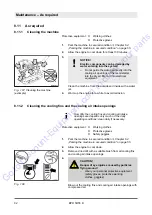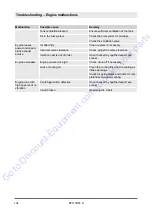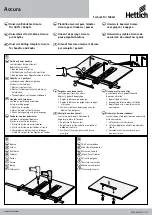
8.11.5.2
Battery service during prolonged machine downtimes
WARNING!
Danger of injury caused by exploding gas mix-
ture!
–
Remove the plugs before starting to recharge
the battery.
–
Ensure adequate ventilation.
–
Smoking and open fire is prohibited!
–
Do not lay any tools or other metal objects on
the battery.
–
Do not wear jewellery (watch, bracelets, etc.)
when working on the battery.
–
Wear your personal protective equipment (pro-
tective gloves, protective clothing, goggles).
Protective equipment:
n
Working clothes
n
Protective gloves
n
Safety goggles
1.
Switch off all consuming devices (e.g. ignition, light).
2.
Measure the open-circuit voltage of the battery at regular
intervals (at least 1 x per month).
ð
Reference values: 12.6 V = fully charged; 12.3 V = dis-
charged to 50%.
3.
Recharge the battery immediately after an open-circuit
voltage of 12.25 V or less is reached. Do not perform boost
charging.
ð
The open-circuit voltage of the battery occurs approx. 10
hours after the last charging process or one hour after
the last discharge.
4.
Switch off the charging current before removing the charging
clamps.
5.
After each charging process allow the battery to rest for one
hour before taking it into service.
6.
For standstill periods of more than one month you should
always disconnect the battery. Do not forget to perform reg-
ular open-circuit voltage measurements.
8.11.5.3
Measures before restarting
1.
Replace the fuel filter.
2.
Replace the air filter.
3.
Change the engine oil and clean the oil filter.
4.
Check cables, hoses and lines for cracks and leaks.
5.
Start the engine and run it for 15 to 30 minutes with idle
speed.
Maintenance – As required
BPR 50/55 D
95
Go
to
Discount-Equipment.com
to
order
your
parts
















































